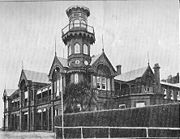
Clyde School
Encyclopedia

Clyde School in Woodend
Owing to its founders, the school was nominally Anglican in its denomination at this time and it expanded rapidly. By 1917 it had an enrolment of nearly 200 girls spread over five buildings. Partly to relieve overcrowding but mainly to create an educational environment free of the distractions of post-war Melbourne, Isabel Henderson decided to relocate the school. In September 1918 she purchased the former mountain golf resort, Braemar House, near Woodend, and moved her school there in 1919. In 1921 Clyde Woodend became a public school after a vigorous fund-raising campaign by a number of well-connected Old Girls. The following year, Isabel Henderson retired to England and Miss Dorothy Tucker, a domestic science teacher from New Zealand, took over as principal.Less charismatic than her predecessor, Miss Tucker nevertheless maintained a well-disciplined, conservative boarding school. Enrolments expanded rapidly during the 1920s but the Great Depression saw numbers plummet. Rigorous cost-saving and an austere regime ensured the school’s survival when many other schools closed. The struggles took their toll on Dorothy Tucker who suffered a nervous collapse in 1935. After a short interregnum under Helen Mathieson, the school appointed Olga Hay, a protégé and old family friend of Isabel Henderson, as headmistress in 1937.
Strongly influenced by her forward-thinking mentor Isabel Henderson, Olga Hay began her tenure with a raft of innovations. However, after Miss Henderson’s death in 1940, Olga Hay’s regime became more conservative. During the 1940s and '50s, Clyde School gained a reputation as one of Australia’s most prestigious (and expensive) schools, though not known for high academic achievement. By the time she retired in 1959, Olga Hay had brought great economic success and stablilty to the school.
Joan Montgomery became principal of Clyde School in 1960 and immediately set about raising academic standards. A highly respected educationist, Joan Montgomery embarked on a modernisation program that included a purpose-built library and science laboratories. Before she left Clyde in 1968, Joan Montgomery recommended that the school open its doors to ‘day girls’ to increase its catchment.
Closure and amalgamation
Alice Pringle took over as principal in 1969. Times were changing, and the school faced financial difficulties. The landed gentry from whom the school sourced its pupils were disappearing. Wool prices were down. Enrolments were static and costs were soaring. Many attempts were made to attract new boarders, but the school was failing financially. In 1975 Clyde School at Woodend closed. The following year, Braemar SchoolBraemar College
Braemar College is an ecumenical co-curricular private school located on Mount Macedon in Woodend, Victoria, Australia. Initially the school's board consisted of representatives from the three local municipalities and the three local Christian denomination churches...
, a low-fee coeducational day school, opened on the site. It still operates there today.
In 1976 Clyde School, Geelong Church of England Grammar School and Geelong Church of England Girls' Grammar School ("the Hermitage") amalgamated, and today the combined school continues as Geelong Grammar School
Geelong Grammar School
Geelong Grammar School is an independent, Anglican, co-educational, boarding and day school. The school's main campus is located at Corio, on the northern outskirts of Geelong, Victoria, Australia, overlooking Corio Bay and Limeburners Bay....
. Clyde House at Geelong Grammar perpetuates the school’s name.
School history
The Clyde Old Girls’ Association (COGA) continued to operate after the amalgamation and gathered together an impressive set of archives on Clyde School. In 2004 COGA commissioned a history of the school, which was researched and written by Melbourne writer Melanie GuileMelanie Guile
Melanie Guile is an Australian writer for children and adults. She was born in the north of England in 1949 and migrated to Australia at the age of five....
. Clyde School: An Uncommon History was published by COGA in 2006.
Headmistresses
- Miss Isabel Henderson (1910–23)
- Miss Dorothea Tucker (1923–36)
- Miss Olga Hay (1937–59)
- Miss Joan Montgomery (1960–68)
- Mrs G. Pringle (1969–75)
School journal
The Cluthan was the journal of Clyde School and Clyde Old Girls' Association until the school's amalgamation with Geelong Grammar SchoolGeelong Grammar School
Geelong Grammar School is an independent, Anglican, co-educational, boarding and day school. The school's main campus is located at Corio, on the northern outskirts of Geelong, Victoria, Australia, overlooking Corio Bay and Limeburners Bay....
and the Hermitage in 1976. Since that time it has been the journal of the Old Girls' Association. Its name is derived from the Latin for Clyde, Clutha.
Notable alumnae
- Elisabeth MurdochElisabeth Murdoch (senior)Dame Elisabeth Joy Murdoch AC, DBE is an Australian philanthropist. She is the widow of Australian newspaper publisher Sir Keith Murdoch, and the mother of international media proprietor Rupert Murdoch. When Keith Murdoch was knighted, in 1933, she was styled Lady Murdoch...
, philanthropist - Peggy Glanville-HicksPeggy Glanville-HicksPeggy Glanville-Hicks was an Australian composer.- Biography :Peggy Glanville-Hicks was born Melbourne in 1912. At age 15 she began studying composition with Fritz Hart in Melbourne...
, composer - Joan LindsayJoan LindsayJoan Lindsay, Lady Lindsay was an Australian author, best known for her "ambiguous and intriguing" novel Picnic at Hanging Rock.-Life:...
, author

